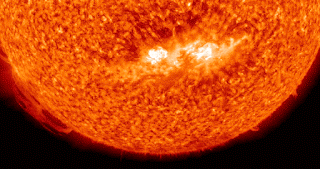For the first time scientists have used data analysed by the public to make a real-time prediction of a solar storm that should hit Earth today (Monday 13 December), thanks to the Solar Stormwatch web project.
The initiative, launched in February by the Royal Observatory, Greenwich (ROG), in partnership with the STFC Rutherford Appleton Laboratory and the Zooniverse citizen science project, makes it possible for anyone with an internet connection to get involved in the latest solar research by helping to spot and track storms as they erupt from the surface of the Sun. These collective measurements enable scientists to forecast the arrival of storms far enough in advance to issue effective pre-emptive warnings for the first time.
The Sun is much more dynamic than it appears to the naked eye. Intense magnetic fields churn and pummel the Sun’s atmosphere and they store enormous amounts of energy that, when released, can hurl billions of tons of material out into space in eruptions called Coronal Mass Ejections (CMEs) – or solar storms.
The latest storm identified by the project is predicted to hit Earth at 07.32 GMT on 13 December. Solar storms have the potential to interfere with communication satellites, upset GPS navigation systems and also pose a health risk to astronauts on the International Space Station. In severe cases they can even knock out entire power grids causing widespread disruption here on Earth. On a gentler note, the particles making up a solar storm can produce beautiful displays of the Northern and Southern Lights as they collide with the Earth’s upper atmosphere. Scientists are not overly concerned about the effects of the current storm, but the early warning provided by Solar Stormwatch will allow precautionary measures to be put in place.
In the past solar scientists were only certain an approaching storm was directed towards Earth a few hours ahead of impact, but data from the NASA STEREO mission used by the Solar Stormwatch project allows Earth-directed storms to be identified up to three days in advance, enabling space agencies and power companies to take steps to limit any damage. In order to identify hazardous solar activity, the solar wind needs to be monitored constantly – a task that is too much for scientists to deal with on their own – so the Solar Stormwatch website utilises the spotting skills of the public to alert them to incoming storms.
The STEREO mission is made up of a pair of satellites in orbit around the Sun which give scientists a constant eye on the ever-changing solar surface. The UK has a major input in STEREO, providing the two widest-field instruments, the Heliospheric Imagers, which provide Solar Stormwatch with its data. Each imager has two cameras helping STEREO stare across the 150 million kilometres from the Earth to the Sun.
The Solar Stormwatch website is specially designed to be easy and fun to use. Once a keen-eyed user has identified a storm, Solar Stormwatch members are asked to mark its progress across the STEREO images using the ‘Trace It’ activity. Scientists can then use this information to work out the speed and direction of the storm and predict when it will arrive at Earth.
Further information can be found on the RAL Space website




Be the first to comment on "Significant Solar Storms to Hit Earth TODAY"